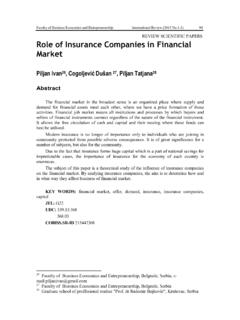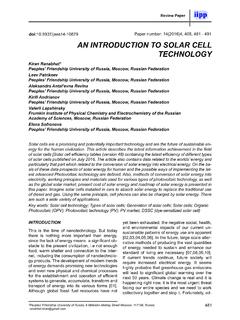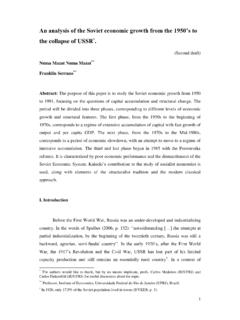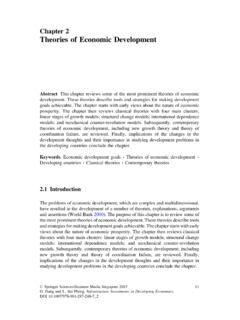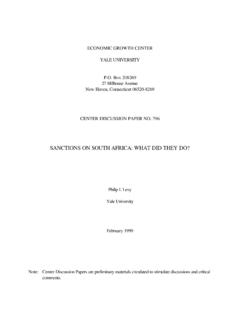Transcription of ECONOMIC GROWTH AND DEVELOPMENT
1 (JPMNT) Journal of Process Management New Technologies, International Vol. 3, , 2015. 55 ECONO MIC GROWTH AND DE VELOPMENT Mladen M. Ivic, PhD, PIM University of Banja Luka, 78000 Banja Luka, +38765-494-581 Abstract: Under ECONOMIC GROWTH mean constantly increasing volume of production in a country, or an increase in gross domestic product as the main quantitative indicators of production for a period of one year. ECONOMIC DEVELOPMENT is not only quantitative changes when it comes to the ECONOMIC position of the country, but also qualitative changes (changing the ECONOMIC structure, the emergence of new sectors and industries, new jobs, ).
2 They lead to a better and more complete satisfaction of all human needs. Production per capita is a measure of the ability of a society to achieve their goals of social and ECONOMIC DEVELOPMENT , all in order to meet the constantly growing social needs. The increase in output per capita in ECONOMIC theory is expressed as ECONOMIC GROWTH , without which no ECONOMIC DEVELOPMENT , but does not have any ECONOMIC GROWTH to be a function of ECONOMIC DEVELOPMENT . Keywords: GROWTH , DEVELOPMENT , Investment, Economy, Equity, Changes. Introduction To meet the constantly growing needs of the population, human society is forced into a process of constant renewal of production of various material goods and services.
3 This constant renewal of the production process, which is associated with distribution, exchange and consumption, that is, as we have defined these four stages - social reproduction, is a general legality and necessity in every mode of production. We note that there is a simple, scaled and expanded social reproduction, and that the volume of production may, from year to year, remain the same, decrease or increase. Bearing in mind that the scope of societal needs, continuously growing, then as general legality imposes expanded social reproduction process. That is why we say that the extended theory of social reproduction represents both ECONOMIC theory or ECONOMIC DEVELOPMENT .
4 Analysis of the ECONOMIC conditions or ECONOMIC DEVELOPMENT very early became the object of study of political economy. Even at the time of the physiocrats, their main representative Francois Kene, explored the laws of restoring production in the macro scale. However, the level of DEVELOPMENT of modern ECONOMIC theory of political economy is not expected only to explain the process of social reproduction, but to perform an ECONOMIC analysis and thus to point out the possible choice of means, ways and methods that can be used for the realization of the objectives of ECONOMIC DEVELOPMENT . In this way, ECONOMIC theory formed the basis on the basis of certain decisions are made that are used for regulating and directing the flow of the process of social reproduction.
5 1. The Concept of ECONOMIC GROWTH and DEVELOPMENT ECONOMIC GROWTH include changes in material production and during a relative short period of time, usually one year. In ECONOMIC theory, under the concept of ECONOMIC GROWTH implies an annual increase of material production expressed in value, the rate of GROWTH of GDP or national income. GROWTH can be achieved, for it does not achieve the developmental course of the economy. So ECONOMIC DEVELOPMENT amounts (JPMNT) Journal of Process Management New Technologies, International Vol. 3, , 2015. 56 involves not only an increase in material production, but also all the other socio- ECONOMIC processes and changes caused by the influence of ECONOMIC and beyond ECONOMIC factors.
6 ECONOMIC DEVELOPMENT is therefore expressed in a longer period of time. ECONOMIC DEVELOPMENT of an economy consists of a series of structural changes. The ECONOMIC DEVELOPMENT of the country will be achieved through greater participation of the processing capacity of industrial production (secondary sector), and at higher levels is increasingly dominated by service sector (tertiary sector). For the ECONOMIC DEVELOPMENT of any country is also of great importance and changes in production structure and introduction of new products, new products, new techniques and technologies, new processes of production, raw materials, new energy sources.
7 Changes in the distribution of factors of production, ie in their new location, and not only labor, but of the entire technical potential. As for the operating assets, reallocation of technical potential is done through the engagement of cash accumulation, in order to build new generating capacity. ECONOMIC DEVELOPMENT means greater and more effective involvement of the economy of a country in the international economy. The DEVELOPMENT includes the ever-growing share of accumulation in the national income. Thus, ECONOMIC DEVELOPMENT represents a very complex process and phenomenon. ECONOMIC GROWTH , measured by the percentage increase in national income per capita, can not really be realistic indication of the achieved level of ECONOMIC DEVELOPMENT (Peru, 1986).
8 ECONOMIC DEVELOPMENT is not just an increase in GDP and national income, but all the long-term socio- ECONOMIC changes in the economy of a country. It is very important that, above all, political economy, deals with the problems of ECONOMIC DEVELOPMENT . First of all, the purpose of creating and managing DEVELOPMENT and ECONOMIC policy. 2. ECONOMIC GROWTH and Capital Accumulation To better understand capital accumulation and technological changes affecting the economy, it is necessary to elaborate neoclassical model of ECONOMIC GROWTH . This model was developed by Robert Solow, who in 1987 received the Nobel Prize for this model and other contributions to the theory of ECONOMIC GROWTH .
9 The neoclassical model of ECONOMIC GROWTH describes an economy in which a single homogeneous output produced two inputs: capital and labor. Here is the GROWTH of labor out of the reach of economics and is not affected by the ECONOMIC determinants (Ristic et al. 2006). In addition, the assumption is that the economy is total competition and full employment, so that it can analyze the GROWTH of potential output. In the analysis of ECONOMIC GROWTH , economists emphasize the need to increase capital equipment, which means that the amount of capital per worker is constantly increasing. Examples include the increase in capital equipment multiplication of agricultural machinery and irrigation systems in agricultural production, rapid railways, highways in transportation, computer and communication systems in banking, etc.
10 Technological Change and ECONOMIC GROWTH Based on the historical genesis of the DEVELOPMENT is easy to see that the technological changes caused ECONOMIC improvement of manufacturing capabilities in Europe, North America and Japan. (JPMNT) Journal of Process Management New Technologies, International Vol. 3, , 2015. 57 Technological changes include changes in production processes or the introduction of new products in order to increase output or increasing output from the same amount of inputs. The most significant technological developments in the modern world took place in electronics, computers, telecommunications, aviation industry and so on.
